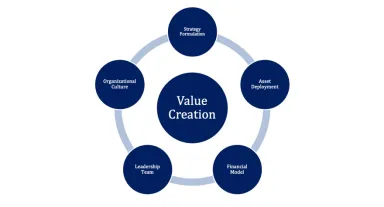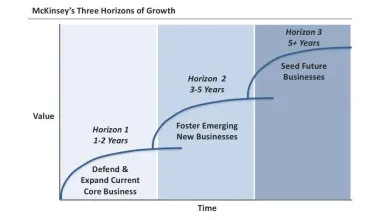
Power Shift: Battery Adoption in Electrical Utilities
This white paper presents a student-authored summary of an applied capstone project completed as part of LeBow’s Lawrie Advanced Global Leadership Program. Each project reflects the student’s integration of the Lawrie leadership model within a specific industry, company or professional context. Together, these papers highlight the practical application of the program’s five core concepts – strategy formulation, asset deployment, financial modeling, leadership and culture — in diverse, real-world business settings.

Abstract
The U.S. power grid is transitioning away from fossil fuels to carbon-free sources. This energy transition requires adopting new technologies, such as utility scale batteries to enhance grid performance, integrate renewable energy, and improve customer experiences. This paper applies the Lawrie model to assess how electric utilities can effectively incorporate batteries into their operations and evaluates the financial, operational, and leadership challenges that must be addressed for successful deployment.
The Lawrie model seeks to create value by prioritizing strategy formation, asset deployment, financial models, leadership teams, and organizational culture. While many MBA programs offer courses on these topics, the Lawrie model emphasizes integration among these components.
Introduction
The electric grid is a complex system integrating technologies ranging from early 20th century infrastructure to cutting-edge IoT and data analytics. Recent advances in battery technology have made utility-scale energy storage more affordable, safer, and easier to install. These advancements allow utilities to store excess energy during peak production periods and release it when demand is high or when renewable sources are not produced.
Batteries play a crucial role in stabilizing the grid, reducing reliance on fossil fuels, and enhancing overall energy security. They also contribute to improving customer experience by reducing power outages and increasing grid reliability.
Batteries are a strategic opportunity for electric utility companies to improve grid performance, incorporate renewable energy, and enhance customer experience. Using the Lawrie model, this analysis provides a structured approach to evaluating how batteries can be effectively incorporated into utility operations to maximize long-term benefits.

Lawrie Model
The Lawrie model emphasizes that business success and value creation are based on five fundamental drivers: (1) strategy formulation, (2) asset deployment, (3) a financial model that supports the strategy while it creates profits, (4) leadership team, and (5) organizational culture.
While these elements are well understood as key components to a plan, their integration management is key to value creation. Conventional wisdom and theory suggest that strategy alone defines business success. The Lawrie model highlights that strategy is only viable when supported by strong leadership, a robust asset deployment program, a financial model that aligns investments with profits, and an organizational culture that fosters execution.
This perspective is not only applicable to for-profit enterprises but is also relevant to nonprofits, where key drivers such as asset allocation, financial sustainability, leadership, and culture play equally vital roles.
Strategy
The first phase of the Lawrie model identifies an appropriate strategy. While strategy can have many definitions, the focus for this analysis involves identifying enablers to gain and sustain a competitive advantage and the ability for executives to influence the firm’s performance. During the Lawrie Advanced Global Leadership Program at Drexel LeBow, conversations with mentors, faculty, and peers guided “big picture” discussions.
The McKinsey three horizon model was used to provide context behind technologies reshaping electric utilities. The Three Horizons Model provides context on how to best use technologies over three levels of maturity:
- Horizon One includes existing technologies that can improve current operations
- Horizon Two includes emerging technologies - something that can be used today, but not widely used
- Horizon Three manages early-stage, high risk technologies

Batteries are a Horizon Two technology. When working with horizon 2 technologies, companies must develop capacity and look towards future cash flows to determine value.
When further analyzing the opportunity, three stakeholder groups were identified - customers, regulators, and internal stakeholders. While these groups are all intertwined, batteries offer unique benefits to all groups:
| Stakeholder Group | Benefit |
|---|---|
| Customers | Fewer and shorter outages, potential cost savings associated with improved operational efficiency |
| Regulators | Help meeting climate goals, constituents happy with utility level of service |
| Internal | Can utilize resources for other projects and initiatives |
Asset Deployment
The next stage of the Lawrie model is to identify the assets needed to execute the strategy. Both tangible and intangible assets were compared with assets needed to deploy status quo grid improvements.
| Asset | Status Quo | Battery |
|---|---|---|
| Spare parts | Large number of unique items | Fewer components |
| Maintenance staff | Large teams | Less maintenance required |
| Funding | Normal business channels | Potential for grants |
| Real estate | Need large parcels | Comparatively smaller land acquisitions |
| Permitting | Large utility projects are notoriously difficult to permit | Less obtrusive facilities but municipalities have less experience |
| Internal expertise | Knowledgeable technical and maintenance staff | None-to-limited within current utilities |
| Internal processes | Currently existing and refined over years of operations | Must be developed |
Many of the tangible assets are lower cost for batteries. Battery systems are relatively simple and require less maintenance. On the other hand, utilities would have to build expertise in a new field to support battery deployment. These intangible assets present the biggest risk to deployment.
Financial model
The financial model provides a tool to track progress toward executing the strategy. Models and metrics used should be grounded in day-to-day needs such as meeting cash flow or operational benchmarks. Strategic and tactical measures were considered with an emphasis on identifying insightful leading and lagging indicators.
Leading indicators would measure the company’s process towards adopting batteries. The primary indicator would be the quantity of engineering studies performed where batteries were assessed as an option. This indicator allows the company to start incorporating batteries into their toolbelt without deploying one without proper justification. The McKinsey three-horizons model recommended using Net Present Value to assess adoption, which would help guide studies.
Lagging indicators would show the performance benefits of batteries. Utilities could compare financial savings, as well as compare the performance of applications with and without batteries.
Leadership
The Lawrie Program reviews two sides of a business: the hardware, consisting of strategy, assets, and financial models; and the software, consisting of leadership and culture. When analyzing leadership teams, the framework recommends seeking out executives who have repeatedly demonstrated the behaviors that are needed to execute the desired strategy.
Mentors within the Lawrie program recommended using the Leadership Signatures Patterns framework from Heidrick & Struggles to identify the behaviors needed to execute the strategy. Hiring leaders with the ability to navigate complexity would be critical when building the team. Given that this is a new technology, leadership would need to define a clear vision in the face of uncertainty.
Culture
To deploy batteries within an existing organization, it is important to bring in people who can act as ambassadors for battery technology. Given the uncertain nature of this technology, team members would need to exhibit resilience when projects do not proceed as expected.
The Lawrie model emphasizes being thoughtful about organizational culture. While it is possible to rely solely on technical expertise when making hiring and promoting decisions, it is important to make sure that candidates are comfortable with the uncertainty associated with adopting new technology.
The Kotter change management model was also used to identify actions that should be taken to build an appropriate culture in conjunction with intentional hiring decisions. Creating a sense of urgency and building coalitions were two critical points that were worth considering.
The urgency stems from ongoing issues that grid operators are facing, and coalition building involves reaching out to people outside of technical organizations to build broad comfort. Given the IT complexities of monitoring and controlling remote assets, bringing IT into the project’s coalition early on is critical for long-term project success.
Recommendation
After analyzing the opportunity using the Lawrie model’s subcomponents, a go or no-go decision must be made. The framework provided a comprehensive understanding that guided many internal discussions. The recommendation to pursue battery projects was made. The recommendation was supported with context and clarity provided by a rigorous analysis. Ultimately, the potential benefit to customers made batteries worth piloting.
Conclusions
The Lawrie program imparts a unique insight into the minds of people in executive leadership positions. Thanks to conversations with Michael Lawrie and his team, students have an opportunity to ask questions and see business from a different vantage point. While the framework was used to analyze how batteries can support the grid, the true beauty of the framework is its flexibility. In an increasingly complex world, the rationale behind decisions is often more important than the decisions themselves.